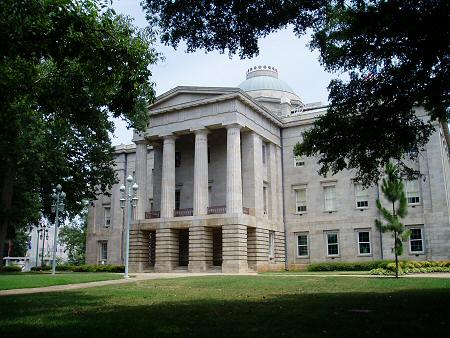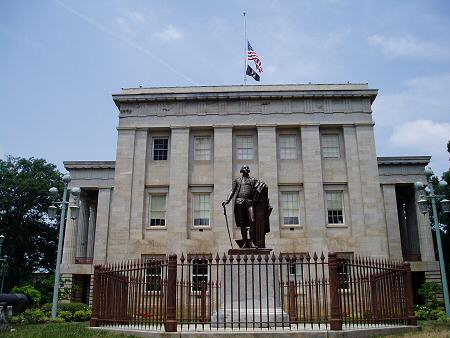|
The Capitol in the
Civil War
The North Carolina State Capitol served the state
throughout the Civil War. Until Raleigh's surrender in 1865 and subsequent
occupation, the building was where the state's wartime legislatures met.
Gov. Zebulon B. Vance maintained his office in the southwest suite on the
first floor. In addition, Gen. John A. Logan organized the Society of the
Army of the Tennessee, one of the first Union veterans organizations, in
the Treasurer's Office (the southeast suite on the first floor) on April
14, 1865.
For North Carolina, the war began at the Capitol. On May 20, 1861,
legislators signed the Ordinance of Secession in the House of Commons
Chamber. As soon as it was signed, a handkerchief was waved from the
window of the office of the Speaker of the House. When that signal was
given, a great celebration began on the building's Union Square, including
a 100-round artillery salute and music from a military band. Legend has it
that the first blood shed for North Carolina during the war occurred that
day as a bulldog, startled by a gun salute, severely bit one of the
cannoneers of Manly's Battery in the seat of his pants.
For the next four years, the Capitol saw a flurry of activity. The
building was used as a supply depot and the ladies of the town met in the
rotunda to fashion uniforms, haversacks, and bandages. Confederate troops
were brought to the capital city for training and then sent to the front
lines. On April 13, 1865, however, Raleigh and the Capitol began to
experience the war firsthand as Gen. William T. Sherman's army, led by
Judson Kilpatrick's Third Cavalry Division, marched into town, beginning
the occupation of the city by the Federal Army.
Second Lt. George Carr Round of the U.S. Army Signal Corps was sent to the
Capitol to set up a signal station atop the dome of the building to relay
signals from General Sherman's headquarters (in the Governor's Palace at
the south end of Fayetteville Street) to troops encamped around the city.
Not being familiar with the structure, Round, a Pennsylvanian, carefully
made his way to the roof of the Capitol and climbed the lightning rod
cable on the dome. While attempting to set up his station, he hopped over
its anthemion crown, thinking he would land on a flat roof. To his
surprise, he landed on the glass skylight of the rotunda and crashed part
of the way through. Supported by a wire mesh over the glass and hanging on
to the cast-iron crown, Round was able to save himself from falling over
97 feet to the stone floor of the rotunda below. (He later recalled he
could hear the glass shattering on the floor beneath him.) The next day,
he was able to make his way back up to the roof to set up a signal
station. He also set up an office in the Senate Chamber and bivouacked in
its southeast committee room.
From his rooftop vantage point, Round was able to track troop and civilian
activities in Raleigh, including the procession of troops down
Fayetteville Street�an event that was also observed by Generals Sherman
and Ulysses S. Grant. Grant had arrived in Raleigh on April 24th to inform
Sherman that the surrender he had negotiated with Johnston had been
rejected by the Federal government. On April 26th, Gen. Joseph E.
Johnston, after renewing negotiations with Sherman, surrendered
approximately 90,000 Confederates at the Bennett farmhouse outside of
Durham Station. Round asked for and received permission to fire colored
signal rockets to inform Sherman's army of the surrender.
While the signal rockets were being set off, one misfired, sending its
fiery blast into Round's face. Fortunately, the lieutenant suffered only
minor injuries, including a lame shoulder and a lacerated wrist, so he was
able to finish sending his message. It became the last signal message of
the Civil War, reading, "Peace on earth, good will to men."
The Capitol itself was spared the total destruction that had befallen the
old statehouse in Columbia, South Carolina. Before retreating westward,
Governor Vance sent a peace delegation, led by former governors David L.
Swain and William A. Graham, to Sherman asking that the Capitol, with its
library and museum, be spared. As a result, the Capitol suffered little
damage. Upon entering the building, however, Federal soldiers discovered
several of the museum cases broken open, strewn documents and maps in the
legislative chambers, and an inkwell overturned on a marble bust of John
C. Calhoun (now in the N.C. Museum of Art's collection) in the Senate
Chamber. Also discovered were lenses and mechanisms from several coastal
lighthouses stored in the upper rotunda, as well as captured Union flags
suspended from the galleries in the House and Senate Chambers. The state's
official copy of the Bill of Rights was stolen by an Ohio soldier.
Courtesy of North Carolina Office of Archives and
History |


